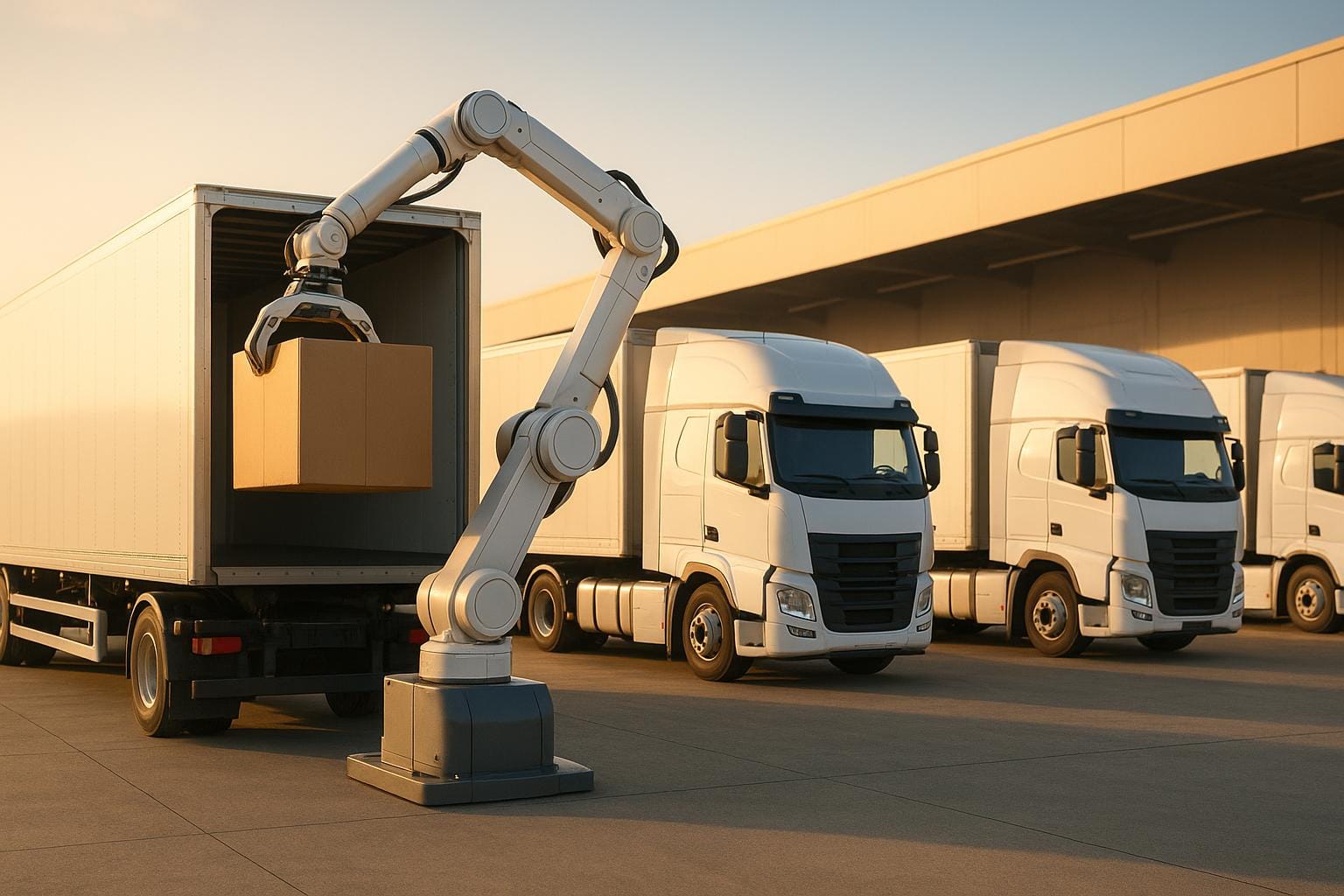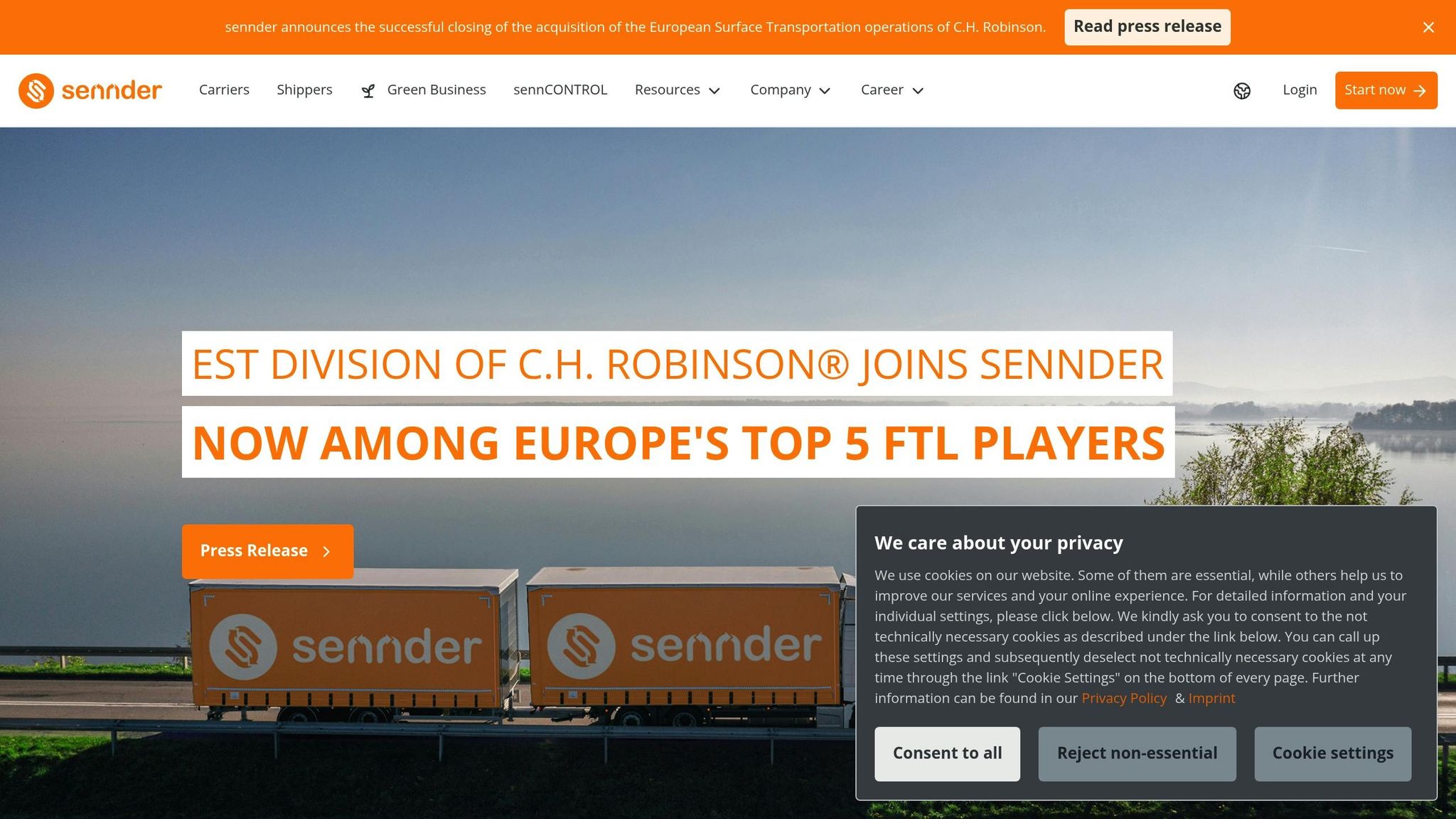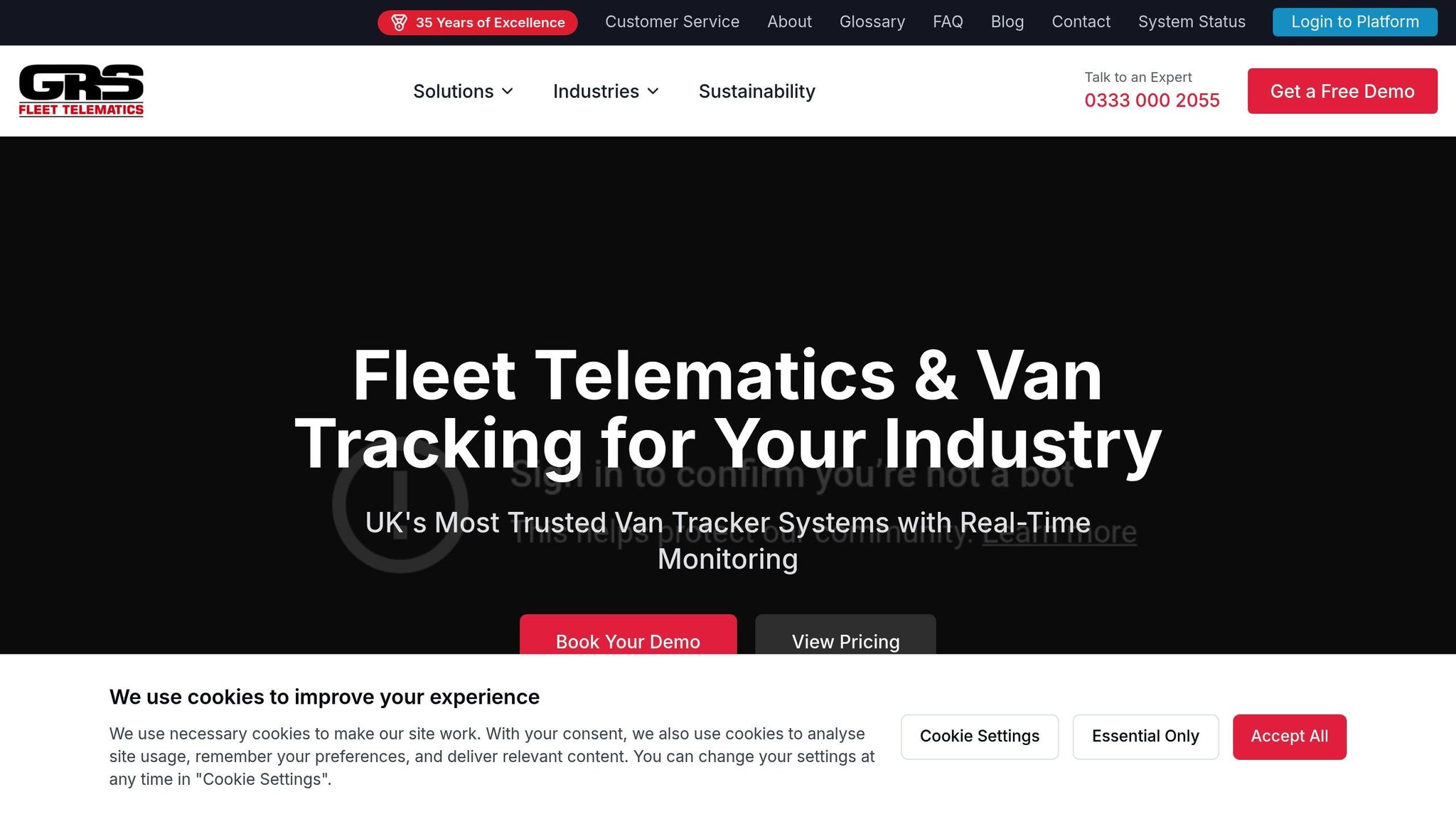AI Load Management for Fleet Efficiency
Michael Bar

AI load management is transforming UK fleet operations by reducing inefficiencies like empty miles and poor vehicle utilisation. Using real-time data and machine learning, this technology optimises load distribution, route planning, and vehicle assignments. It helps fleets cut costs, comply with regulations, and improve delivery performance. Key benefits include:
- Fewer Empty Miles: Matches loads to vehicles in real-time, reducing trips without cargo.
- Better Vehicle Use: Ensures optimal weight distribution, delivery sequencing, and fleet composition.
- Cost Reduction: Saves fuel, streamlines routes, and lowers maintenance expenses.
- Regulatory Compliance: Simplifies adherence to Low Emission Zones and driver regulations.
- Environmental Impact: Reduces emissions by improving delivery efficiency.
Platforms like GRS Fleet Telematics enhance these systems by providing reliable data and monitoring tools, ensuring fleets run smoothly and efficiently. This approach is vital for staying competitive in the face of rising costs and stricter regulations.
TrueML Talks #33 | Fleet management using ML at Sennder

Benefits of AI Load Management for Fleet Operations
AI load management offers a range of improvements for fleet operations, addressing inefficiencies that have long challenged the logistics industry. For UK fleet operators, this technology provides a much-needed edge in a highly competitive market. Here’s how AI helps reduce empty miles, boosts vehicle utilisation, and cuts costs.
Reducing Empty Miles
Empty miles - journeys where vehicles travel without cargo - are a major drain on profits. AI load management tackles this issue by continuously analysing available loads and matching them with vehicle locations and schedules in real time.
By using live data, the system identifies nearby loads that align with a vehicle’s capacity and driver’s available hours once a delivery is completed. This dynamic matching reduces the number of empty runs.
AI also takes into account factors like vehicle type, driver qualifications, and delivery timeframes when assigning loads. For example, refrigerated vehicles are prioritised for temperature-sensitive goods, while drivers with ADR certification are matched with hazardous materials. Additionally, the technology excels in backhaul optimisation - finding return loads for vehicles after deliveries - by leveraging historical data and current market trends. This approach ensures vehicles are used more efficiently across all routes.
Better Vehicle Utilisation
AI load management enhances vehicle utilisation by focusing on weight distribution, cargo compatibility, and delivery order efficiency. It determines the best way to load vehicles, minimising unnecessary unloading and reloading during deliveries.
For larger vehicles, the system considers axle weight limits, load balance, and stability to ensure compliance with DVSA regulations. This not only reduces wear and tear on components but also improves fuel efficiency.
Delivery sequencing is another area where AI shines. By optimising the order of collections and drop-offs based on factors like customer availability, traffic conditions, and unloading requirements, the system reduces dwell time at each stop. As a result, drivers can complete more deliveries within their legal operating hours.
AI also helps optimise fleet composition by analysing historical data to recommend the right mix of vehicle sizes and types for specific routes. This prevents scenarios where oversized vehicles are used for small loads or multiple smaller vehicles are dispatched unnecessarily.
Additionally, the system integrates maintenance schedules into its planning. Vehicles nearing service intervals might be assigned shorter routes, while newer or recently serviced vehicles handle longer or more demanding trips. This proactive approach helps avoid unexpected breakdowns and keeps the fleet running smoothly.
Cost Savings and Compliance
AI’s ability to reduce empty miles and improve vehicle utilisation translates directly into cost savings. Streamlined routes save fuel, while improved planning boosts driver productivity. With less time spent waiting for instructions or navigating inefficient routes, drivers can handle more deliveries within their legal hours, potentially reducing the need for extra vehicles or personnel.
Regulatory compliance is also simplified. AI systems automatically monitor drivers’ hours, vehicle weights, and route restrictions, ensuring adherence to UK and European regulations. For example, planned routes can be adjusted to meet Low Emission Zone requirements in cities like London, Birmingham, and Manchester, helping fleets avoid fines.
Maintenance costs are lowered as well. By preventing overloading and ensuring vehicles operate within optimal conditions, the system reduces wear on engines, tyres, and other components. Maintenance can even be scheduled during quieter periods, minimising downtime.
There’s also potential for insurance savings, as better load distribution and optimised routing reduce the risk of accidents. Additionally, AI supports sustainability goals by cutting emissions - a growing priority for many businesses. Companies increasingly require logistics partners to demonstrate measurable reductions in their carbon footprint, and AI load management can help fleets meet these expectations.
For fleets using platforms like GRS Fleet Telematics, these benefits integrate seamlessly with existing tracking systems, offering a complete view of operational performance and cost efficiency.
How AI Load Management Works
To truly optimise fleet operations, it's essential to understand how AI load management functions. This process unfolds in three interconnected stages, working together to create a system that makes fleet decisions quickly, based on data, and with cost efficiency in mind.
Data Collection and Analysis
The foundation of AI load management lies in gathering data from a variety of sources within your fleet. Telematics devices play a key role here, continuously collecting information like vehicle location, speed, fuel consumption, engine performance, and driver behaviour. Meanwhile, external inputs - such as traffic updates, weather forecasts, and delivery schedules - add another layer of context. Historical data, including past delivery times, fuel usage, and route efficiency, further enriches this dataset by highlighting long-term patterns.
Once all this data is in hand, machine learning algorithms dive into the analysis. They process the information to uncover trends and pinpoint areas for improvement. For instance, they may identify routes that consistently save time, strategies to optimise fuel use, or patterns of delays in certain areas during peak hours. These insights are then fed into the system to guide real-time decision-making.
Real-Time Adjustments
What sets AI load management apart is its ability to adapt on the fly. For example, if a delivery is completed ahead of schedule, the system immediately searches for nearby loads that align with the vehicle's capacity and the driver's available hours. Similarly, it can reroute vehicles to avoid traffic jams, adjust speeds during bad weather, or reassign loads when unexpected events like breakdowns occur.
In cases where a vehicle goes offline, the AI system quickly redistributes its remaining loads to other vehicles, considering factors like proximity, available space, and driver qualifications. This dynamic load matching isn’t a one-time process - it continues as new orders come in, ensuring the fleet operates at peak efficiency. This adaptability makes it an ideal partner for advanced telematics systems.
Integration with GRS Fleet Telematics

The integration of GRS Fleet Telematics takes reliability to the next level. Its dual-tracker technology and geofencing ensure accurate, real-time data, even if a primary tracker fails. This level of precision strengthens the AI system’s ability to match loads and optimise routes effectively.
Real-time tracking feeds critical updates into the AI system, including vehicle locations, speeds, and estimated arrival times. Driver performance metrics - such as instances of speeding or harsh braking - further refine the system’s predictions. Geofencing adds another layer of automation. For example, when a vehicle enters a customer’s premises, the system automatically updates the delivery status and begins searching for return loads. In cities like London or Birmingham, geofencing also helps navigate Low Emission Zones by ensuring compliance or suggesting alternative routes when necessary.
Implementation Strategies for UK Fleets
Integrating AI-driven load management into UK fleets demands careful planning to address challenges like congestion charge zones and adherence to strict driver regulations. A structured approach ensures the system delivers its full potential while meeting the unique operational needs of UK fleets.
System Deployment Best Practices
The success of AI load management starts with a solid telematics infrastructure. High-quality, consistent data is crucial. By integrating telematics devices with fleet management software, you can create a seamless system that supports effective decision-making. Proper integration is key to avoiding data gaps that could hinder performance.
Consolidating data from GPS devices, sensors, and vehicle logs into one unified platform allows AI to allocate loads more effectively. With over 70% of new UK commercial vehicles already equipped with telematics capabilities, the integration process has become far simpler.
Training is another critical factor. Dispatchers, drivers, and fleet managers must be equipped to interpret AI recommendations, know when manual intervention is necessary, and monitor performance metrics effectively.
To streamline operations, connect your fleet management software with other essential systems like ERP, accounting, payroll, fuel card providers, and DVLA databases. This integration ensures that AI decisions account for key business constraints, such as driver hours, vehicle tax, and compliance requirements.
Additionally, define operational priorities and use multi-objective optimisation to balance factors like cost, delivery time, emissions, and driver hours. For instance, fleets operating in Low Emission Zones may prioritise environmental compliance, while those with tight delivery schedules may focus on meeting deadlines. A robust telematics foundation is essential for achieving these goals.
Using GRS Fleet Telematics
GRS Fleet Telematics is a powerful tool for ensuring the continuous, reliable data flow that AI systems depend on. Its dual-tracker technology offers a backup in case the primary system fails, maintaining real-time visibility for accurate AI-driven decisions.
The Enhanced package, priced at £79, includes both a primary tracker and a Bluetooth backup tracker, providing essential redundancy. With a 91% recovery rate for stolen vehicles, it also helps protect the significant investment in fleet management technology.
For £7.99 per month, fleets gain access to SIM data, account management, and the platform itself - making it an affordable solution for operations of any size. Additionally, driver behaviour monitoring generates scorecards to identify training opportunities and improve safety. This data further enhances the AI system’s ability to predict delivery times and evaluate driver performance accurately.
System Auditing and Refinement
To ensure your AI load management system continues to deliver results, regular audits are essential. Monthly checks on data accuracy help verify that telematics data aligns with vehicle performance and the latest machine learning updates.
AI systems for route optimisation and load planning are designed to improve efficiency by reducing empty miles, cutting fuel costs, and enhancing delivery performance. However, quarterly reviews are necessary to ensure the system aligns with business goals and maintains service standards. These reviews also help identify areas where driver satisfaction could be improved.
Performance tracking should focus on metrics like empty miles, fuel consumption per delivery, and on-time performance. While AI dynamically adjusts routes based on live traffic, weather, and delivery changes, analysing these adjustments can uncover opportunities for further refinement or additional training.
IoT sensors combined with AI can also be used for predictive maintenance, helping to identify potential faults before they occur. This reduces breakdowns and extends vehicle lifespan. Regular audits ensure these predictions remain accurate and that vehicle availability assumptions are realistic.
Finally, system refinement involves tweaking AI parameters to adapt to seasonal changes, business growth, or operational shifts. For instance, during the busy Christmas shopping season or summer roadworks, UK fleets may need different optimisation strategies. By continuously auditing and fine-tuning the system, you can ensure it remains efficient and effective throughout the year.
Measuring Success and Continuous Improvement
After implementing operational improvements, the next step is measuring success. This is what paves the way for ongoing fleet optimisation. Tracking system performance effectively is essential for achieving consistent progress and making meaningful refinements.
One powerful approach to drive continuous improvement is adopting a closed-loop management system. By feeding performance results back into your AI, you allow for dynamic workflow adjustments and smarter fleet allocation. This creates a more adaptive logistics system that can respond to changing demands and conditions. The structured feedback loop ensures that critical adjustments are made based on real-world data, enhancing the overall efficiency of your fleet.
Another crucial element is regularly refining core AI models, such as those used for ETA predictions. Incorporating delivery patterns, traffic data, and seasonal variations into these models ensures they remain accurate and relevant over time.
Frequent reviews and updates to these models help your AI stay responsive to shifting conditions, maintaining optimal fleet performance in the long run.
Conclusion: Fleet Efficiency with AI
AI-powered load management is changing the game for fleet operations, tackling long-standing challenges like empty miles and inefficient vehicle use. These systems are designed to address inefficiencies that have plagued the transport industry, offering solutions that improve performance and cut costs.
By using intelligent route planning and load matching, fleets can significantly reduce empty miles and fuel consumption. This means fewer vehicles on the road, which translates to lower expenses on insurance, maintenance, and wages. These savings, paired with improved compliance, create a strong foundation for smarter, data-driven decision-making.
AI also plays a key role in ensuring fleets stay compliant with regulations, helping to minimise penalties and enhance safety standards.
When integrated with GRS Fleet Telematics, AI systems gain access to real-time data, including vehicle locations, driver behaviours, and operational analytics. This combination provides UK businesses with the tools they need to optimise load management and maintain seamless operations.
The efficiencies brought by AI and telematics create a solid strategy for ongoing success. UK fleets that embrace AI-driven load management alongside GRS Fleet Telematics can achieve consistent improvements in efficiency. Beyond addressing immediate operational issues, this technology equips fleets with the insights needed for long-term planning and staying ahead in a highly competitive industry.
FAQs
How does AI load management help reduce empty mileage in fleet operations?
AI load management tackles the issue of empty mileage by leveraging real-time data and intelligent algorithms. These tools match trucks with the best possible next load, taking into account factors like location, timing, and cargo needs. The result? Trucks spend less time running empty, which translates to a big boost in efficiency.
On top of that, AI fine-tunes routes and schedules, helping fleets avoid unnecessary detours and get the most out of their vehicles. Cutting down on empty miles not only saves on fuel expenses but also reduces vehicle wear and tear. Plus, it helps businesses shrink their carbon footprint while enhancing overall operations.
How does GRS Fleet Telematics support AI-driven load management for fleets?
GRS Fleet Telematics: Enhancing Efficiency with AI
GRS Fleet Telematics takes load management to the next level by providing accurate, real-time vehicle tracking and telematics data. This system allows for dynamic route planning, cutting down on empty miles, improving vehicle usage, and fine-tuning fleet operations across the UK.
With these advanced tracking tools, businesses can maximise fleet efficiency, boost productivity, and lower operational costs. All of this is achieved using dependable, secure technology designed to meet specific business needs.
How does AI load management help fleets comply with UK regulations like Low Emission Zones and driver hours limits?
AI load management plays a key role in helping fleets meet UK regulations by using real-time data and smart algorithms to fine-tune operations and stay within legal boundaries.
For Low Emission Zones (LEZ), AI keeps an eye on vehicle emissions and automatically plans routes to steer clear of restricted areas. This not only helps avoid fines but also aligns with goals to reduce emissions.
When managing driver hours, AI processes telematics data to ensure drivers stick to legal limits, such as the 9-hour daily cap and weekly restrictions. It also simplifies scheduling and record-keeping, making compliance straightforward while boosting overall fleet efficiency.